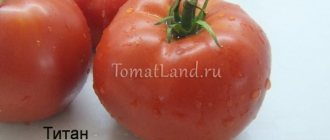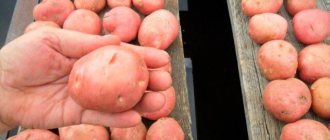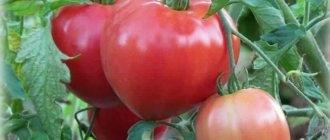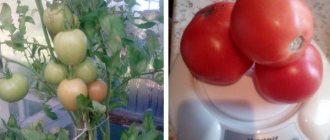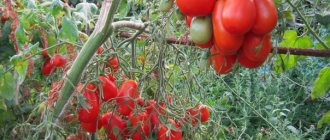Vegetable growing » Tomatoes
0
1816
Article rating
Kira Stoletova
Each vegetable crop in a garden or summer cottage serves to satisfy certain desires of the owner: to surprise with a new original variety, to spend less time and effort on caring for plants. Tomato Legend Tarasenko is the best choice for those gardeners who want to grow good tomatoes for harvesting for the winter.
Characteristics of tomatoes variety Legend Tarasenko
Characteristics of the variety and a description of the features of tomato care will help you make a choice and properly prepare for the new garden season. Creating favorable conditions for a given variety means ensuring an excellent harvest.
History of origin
Legend Tarasenko is a relatively young variety, bred by a Ukrainian physics teacher.
Tarasenko F.M. For a long time he worked on the selection of liana-shaped, tall varieties of tomatoes, and only in 2015 he managed to develop a variety that surprised everyone with its yield when cultivated in open ground. Good fruiting is observed in any weather; taste and unusual shape are another advantage of the variety. The Legend tomato was recognized as the best of more than 50 varieties and hybrids by breeder Tarasenko.
The variety grows well in open ground in the southern regions; in colder climates, it is better to cultivate it in a greenhouse.
Advantages and disadvantages of the variety
The legend Tarasenko has a lot of positive qualities:
- ease of care;
- excellent yield;
- resistance to diseases of the nightshade family;
- adaptation to climatic conditions;
- survival rate in all regions;
- excellent taste of fruits;
- unusual shape;
- versatility in cooking;
- excellent presentation;
- long-term storage;
- long transportations.
The only negative properties include the need to tie up tall bushes and systematically plant the crop.
Description of the variety
A tall variety, plant height can reach 2 meters. A well-developed root system goes to great depths. High-yielding, mid-season variety. The second name that Feodosius Makarovich gave to his latest variety is Nadiya.
Seed material can be collected from grown fruits, since subsequent generations fully retain all the characteristics of the variety.
Description of the bush and fruit
The indeterminate type bush has a large height, the stems have the appearance of vines of medium thickness, brownish with a sparse and weakly expressed edge. The leaves have a shape characteristic of tomatoes, the edges of the leaf blade are finely serrated, and the color is green. The leaf growth pattern is spiral.
Inflorescences are formed in groups of 5 pieces on each stem, the flowers are small and yellow. The variety is classified as self-pollinating, which requires drafts when cultivated in closed ground.
The fruits of Legend Tarasenko are medium in size, weight 110-160 grams, plum-shaped. The skin is thin, evenly colored red, there may be yellow spots near the stalk. Soft homogeneous pulp with 4-5 seed chambers. Pleasant sweet taste.
Distinctive features
Up to 8 fruiting clusters can form on one bush. Each one develops 18-24 tomatoes. The fruits begin to ripen 110-120 days after the first shoots. Initially bred for open ground, but in areas with short summers it is better to cultivate the variety in greenhouses, as the plants bear fruit until the first frost.
High resistance to nightshade diseases and pests.
Characteristic
The mid-late appearance of the variety means that the first fruits ripen by early August, and tomatoes from the topmost clusters can ripen until frost. But in this case, the tomatoes are picked green and left to ripen at home. It is important to note that the taste qualities of such fruits are preserved and are not inferior to those that have ripened naturally.
Advantages and disadvantages
Gardeners include the following advantages of the variety:
- High yield;
- Long fruiting period;
- Good keeping quality and safety during transportation;
- High taste qualities;
- Drought resistant;
- Not subject to cracking;
- Easy to use agricultural technology;
- Universal use of fruits.
Among the shortcomings were noted:
- Demanding requirements for the chemical composition of the soil;
- Height of bushes;
- Uneven fruit ripening;
- The need to regularly prun the bushes.
Tomato yield
One tomato bush of the Legend Tarasenko variety can produce up to 12 kg of harvest per season. Although the fruits are small in size, they reach this level in quantity. The planting pattern should not exceed 3 bushes per 1 square meter. In this case, from 1 sq. m. get up to 32 kg of fruit.
Resistance to diseases and pests
The variety tolerates infections well:
- Root and top rot;
- Brown spot;
- Leaf mold;
- Fomosa.
With improper care and lack of nutrients, it can be affected by tobacco mosaic and late blight. In addition, if pests spread massively in the greenhouse, the plant cannot resist. Spider mites, whiteflies and Colorado potato beetles cause more damage.
Scope applies
The variety is actively used not only for personal purposes of summer residents, but also for commerce. High yields and excellent commercial qualities allow the fruits to be used for sale, for the production of tomato sauces, juices and pastes.
The small size of tomatoes and their dense, non-cracking peel allows you to preserve the whole fruit in marinades or in its own juice. Include tomatoes in fresh salads and other vegetable dishes and stews.
What varieties are there?
Tarasenko worked as a physics teacher in the Sumy region of Ukraine, in the village of Voronezh. On his plot, he grew precisely tall indeterminate varieties - De Barao, Limon Liana, Cosmonaut Volkov, etc.
This breeder, of course, was also involved in breeding his own tomatoes. Ultimately, he obtained varieties that are still very popular among summer residents:
- Tarasenko-1, 2 and 3.
- Anniversary Tarasenko.
It is these varieties of the breeder that have earned the greatest recognition from summer residents. This specialist also developed several less popular varieties of tomatoes: Tarasenko-5 and 6, Combitomat Tarasenko, Nadezhda Tarasenko, Legend Tarasenko. These varieties, judging by the reviews of summer residents, also have good yields and are relatively unpretentious. But gardeners still grow them relatively infrequently.
Growing seedlings
In order to grow high-quality seedlings, it is necessary to begin preparing seeds and soil in advance, and also follow all the rules of agricultural technology.
Seed preparation
You can get the seed yourself or buy it at a grocery store. Preparation and planting are carried out 40-60 days before the intended planting in the ground. It is best to plant Legend Tarasenko tomatoes in early March.
In order to check the germination of seeds, you need to immerse them in water for 15-20 minutes. High-quality seeds will swell and sink, while empty ones will remain on the surface of the water. Such seeds are not suitable for planting.
Before planting the seeds, they are treated with a weak solution of potassium permanganate to neutralize them, then washed and dried. Pre-prepared seeds are dipped into prepared containers with soil.
For better germination, you can use commercial growth stimulants.
Container and soil
Soil for seedlings can be purchased at a garden store or prepared yourself. When harvesting independently, take soil from the garden, humus and peat or sawdust for looseness in equal parts. This soil mixture perfectly allows air and moisture to pass through, which has a great effect on seed germination.
The containers are filled halfway, this is necessary in order to add soil as the seedlings grow. This way the plant will receive more nutrients as it grows. Disposable cups or special peat pots are well suited for seedlings.
Peat containers allow oxygen to pass through perfectly, which allows the root system to actively develop, but the humidity level will have to be controlled. Such pots absorb excess moisture, which can lead to dry soil.
Sowing
The depth of the hole should not exceed 20 mm; after the seed is lowered, it is covered with peat and slightly moistened. The containers must be covered with film and stored in a dark, warm place to create a greenhouse effect.
At a temperature of 22-24*C, the first shoots appear within a week.
Seedling care
As soon as small sprouts appear, the film is removed and the containers with seedlings are placed in a sunny place. The length of the daylight hours should not be less than 12 hours; if there is not enough natural light, then they resort to supplementary illumination with fluorescent lamps or special phytolamps.
Important! Direct sunlight can cause burns on the plant; it is best to protect the window with special films.
Water the seedlings as the soil dries. Warm, settled water is best, watering at least once every 3 days. The main thing is not to flood the soil so that the root system does not begin to rot.
As soon as the seedlings get stronger, they need to be prepared for planting in the ground. To do this, the temperature is gradually lowered to 16 degrees. The plants are kept in such conditions for about 1 week, then they are taken out to the veranda or greenhouse for another 5-7 days. After such hardening, the tomatoes are ready to be planted in the garden.
Planting and care
Legend Tarasenko Tomato seeds are planted as seedlings 60 days before the planned transplantation of the bushes to a new location. Those seeds that are guaranteed to germinate are pre-selected. To do this, they are placed in a 5% solution of salt in water. Drowned grains are suitable for planting.
For 2-3 days they are heated on a radiator or doused with warm air heated to +50-55 degrees for 5 minutes. Soak for 20 minutes in a weak solution of potassium permanganate for disinfection, and then treat with a growth stimulator.
After all manipulations, they are planted to a depth of 1-2 cm in light nutrient soil. Carefully water with a spray bottle and wrap the containers with film. Germinate at a temperature of +20-25. When sprouts appear, the temperature is reduced to +17 and the seedlings are kept cool for at least a week. Then return to heat. It is necessary to place the boxes on a lighted windowsill, and if there is not enough sun, add lamps.
When the seedlings have 2 permanent leaves, they are picked.
Before planting, the soil is fertilized. A little wood ash and humus, as well as mineral fertilizers, are placed in holes half a meter in diameter and up to 40 cm deep, and mixed with soil. 2 bushes are planted in one hole. There is a distance of about a meter between the holes, and one and a half between the rows.
You cannot plant tomatoes twice in the same place, or use beds where potatoes, peppers or eggplants grew last year. Recommended varieties of tomatoes
Mid-season / Tall Hawaiian pineapple User rating: 4/5 Late-maturing / Tall Altai red User rating: 4/5 Early maturing / TallDiana f1 User rating: 4/5 Mid-season / TallGiant pearUser rating: 5/5
- 02 October 2022 21:05:34
The long-awaited time for harvesting has come, and here it is, a real two-meter handsome man, strong, with powerful roots, neat clusters, dotted with graceful bright red fruits. The latest creation of the Ukrainian physicist Tarasenko F.M. is the tomato variety Legend Tarasenko. This species has its own highlight - unusual fruits weighing from 80 to 100 grams, externally resembling cream with an elongated spout.
Growing Tomato
After 55-60 days, the seedlings will be fully strengthened and ready for planting in the ground.
Landing in the ground
Seedlings are planted in the ground at the end of May, when the average daily temperature is above 17*C. Before planting plants, the soil must be prepared.
The place where it is planned to plant tomatoes is dug up and freed from weeds. Form holes 30-40 cm deep; humus or nutrient mixtures, wood ash and mineral fertilizer are poured onto the bottom.
There should be a distance of at least 75 cm between two adjacent plants, and 1 meter between rows. Two seedlings are placed in each hole; this method will allow them to support each other. Then water it abundantly and leave it for 14 days so that the plant can independently adapt to a new place.
Watering and fertilizing
After the plants take root and begin to grow, it is necessary to begin regular watering and fertilizing. Water tomatoes at least once a week with warm water. Watering should be done in the late evening or early morning, the amount should be determined as the soil dries out. Moisture stagnation should not be allowed, as this can lead to the development of fungal diseases and rotting of the root system. High humidity can affect the taste of tomatoes.
After each watering, it is necessary to loosen the soil and remove weeds. This is great for preventing pests. In particularly hot regions, you can mulch the beds with straw, which will help retain moisture in the soil. Mulching with weeds is also acceptable; in addition to retaining moisture, when they rot, the weeds release the necessary nutrients into the ground, which saturate the roots of the plants.
Experienced gardeners recommend feeding the bushes three times:
- 2 weeks after transplanting into the ground. Both mineral and organic fertilizers are better suited for this.
- During the period of active formation of ovaries. Both organic and mineral substances are used.
- During fruiting. It is better to use only organic matter.
Further care
For a good harvest, it is necessary to follow the rules of agricultural technology for this variety:
- Rare but plentiful (at least 5 liters per bush) watering;
- Mulching the soil;
- Tie to a support or plant two bushes in one hole;
- Formation into 2-3 stems, regular removal of lower stepsons and leaves;
- Regular ventilation of the greenhouse;
- Fertilize at least 3 times per season;
- When the daily temperature decreases in the fall, excess flowers and weak ovaries are removed.
Features of cultivation and possible difficulties
The tall growth of plants requires a strong garter to the support; in the case of the tomato variety Legend Tarasenko, not only the stem is tied, but also the fruit-bearing branches, since sometimes they can break under the weight of the fruit.
It is important to stump correctly; when removing shoots regularly, it is necessary to leave a stump 20-25 mm long so that new stepsons do not form in its place.
Description and characteristics of tomato Legend Tarasenko, reviews, photos
Mid-season, indeterminate, high-yielding, reliable tomato variety. Recommended for growing in greenhouses.
The second name of the variety is Nadiya, this is the last variety created by Feodosii Makarovich Tarasenko.
A bush up to 2 meters high , requiring tying to a support and pinching. The best result was obtained when forming a plant with 1 or 2 stems.
The brushes of this variety are complex, with 10-20 ovaries in each.
Basic qualities of fruits
photo by Valentina Redko
The fruits are elongated cream with a drawn-out spout, smooth, glossy, red in color at maturity, weighing 80-100 grams , excellent taste. These tomatoes are great for pickling and canning, and they are also tasty in fresh salads.
Advantages of the variety : high yield, excellent commercial quality of the fruit.
Tomato yield Legend Tarasenko : up to 5 kg of fruit from 1 plant (subject to agricultural practices, watering and fertilizing).
Diseases and pests
Although they say that the crop is resistant to many types of pests and diseases, it can easily become infected from its “neighbors” in the garden. Therefore, it is not recommended to plant tomatoes next to other plants of the nightshade family; we must not forget about crop rotation.
You can use purchased products for the treatment and prevention of diseases only until clusters with fruits form.
To combat pests and diseases, the main thing is to detect them in time. To do this, it is necessary to inspect the bushes and the soil under them once every 2-3 days for signs of disease or pests.
Farmer reviews
The legendary tomato, created by a Ukrainian amateur breeder, has many fans. Here are the opinions of some gardeners:
Olga, Brest: “The clusters contain a large number of fruits, suitable for both canned food and salads. The taste is excellent, sweet, slightly sour. I grow it in a greenhouse, the stem is powerful, but I can’t do without a garter.”
Tamara, Astrakhan region: “I grow the plant in 2 trunks, I have been planting this species for more than 3 years. The vegetables are delicious, just what I need. There is always enough to eat in the summer and to prepare for the winter. I recommend it to everyone."
The nuances of breeding in open ground and in a greenhouse
In closed ground, the height of the plant can reach more than 230 cm, therefore, to limit the growth, the crown of the bush is pinched.
The variety feels best in open ground in the south of the country, but in more northern conditions the crop has been adapted for cultivation in greenhouses and greenhouses without loss of yield. The only peculiarity is that in greenhouses it is necessary to create artificial air ventilation so that the plants can self-pollinate.
Harvesting and application
Fruiting is very extended, the first harvest appears in early August, and the last tomatoes are picked from the bushes in mid-November. Ripe vegetables are universal in use:
- Consumed fresh;
- Used in vegetable salads;
- Add to vegetable stews and other hot dishes;
- Roll up whole;
- Used for making juice, tomato paste and sauces.
Tomatoes are able to retain their presentation for a long time and tolerate long-distance transportation well.


